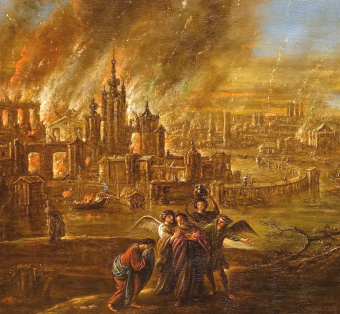Jude belongs, in the original division of the Bible, in a group of writings known as the General Epistles. This fifth grouping of Biblical books also includes the writings of James, 1 and 2 Peter, as well as 1, 2 and 3 John.
[The Inspired Order of Biblical Books!]
Jude is the fourth shortest book in the New Testament in terms of words. It is also tied with Philemon for the third shortest in terms of verses. In regard to the entire Bible, Jude is the fourth shortest in terms of both words and verses. The book of Obadiah has the third fewest verses with 21.
Date Written
Jude, out of the KJV's 27 New Testament books, is the third youngest. It was written from 66 to 67 A.D. The only two books younger than it are 2Timothy (67 A.D.) and Revelation (95 to 96 A.D.).
The Author
The writer of Jude is one of the four half-brothers of Jesus (Matthew 13:55) and the brother of James who was called "the Lord's brother" in Galatians 1:19. Both Jude and James are writers of New Testament books.
Little is known about Jude himself. Prior to Jesus' resurrection he was an unbeliever (John 7:3 - 5) and was likely married (see 1Corinthians 9:5). After the Lord's ascension he was among the 120 disciples who gathered in Jerusalem to pray and await the Day of Pentecost in 30 A.D. (Acts 1:13 - 14).
Jude Outline
Chpt. 1: The book of Jude's stated audience is not an individual (e.g. Titus), church (e.g. Romans), or group of Christians (those in the twelve tribes). It is addressed to believers wherever they may be.
. . . to them that are sanctified by God the Father, and preserved in Jesus Christ, and called (Jude 1:1, KJV).

Although Jude initially suggests he wrote to discuss the common salvation available to all Christians (verse 3), his epistle entails warning believers about false Christians and false teachers infiltrating the church.
Jude begins his short book by encouraging believers to pursue the same faith (beliefs) as was taught by the twelve apostles. This pursuit is critical in order to withstand the false teachings and sinful behavior of pseudo-Christians who are quietly entering the church of God.
[Rules for Studying the Bible!]
One of the false teachings being promoted is that God's grace permits people to live however they choose instead of being required to obey him. Those who support such a belief also deny Jesus' role as our Savior and head of his church (verse 4).
Jude condemns the belief that God is not serious about sin by warning that the ancient Israelites, saved from Egyptian bondage, were ultimately punished for their sins (verse 5). Righteous angels, who rebelled against God and turned themselves into demons, have and will be judged (verse 6). Sodom and Gomorrah, which indulged in all manner of vile sins, eventually received the penalty it deserved for its disobedience.
Those who are pretending to be Christians not only create false doctrines to promote, they also indulge in perverse behavior and reject any authority over them. They willingly follow the deceptions of their own hearts even if they are corrupted by them.
False believers additionally are willing to lead others to sin for their own personal gain (verse 11). They are arrogant fault-finders who flatter others for an advantage. Not having God's spirit, their ultimate goal is to divide and destroy the true church (verse 19).
Jude also utilizes a few colorful metaphors to describe those seeking to make merchandise of and tear apart God's church. They are like unseen spots (rocks) which can endanger a true believer. They are also likened to unstable and deceitful clouds which end up becoming useless since they bless no one (verse 12).
Those who enter the church in order to prey on it are like trees that fail to produce fruit at their appointed time. They are also like raging waves who openly manifest their shame and like wandering stars that are restless and without peace (verses 12 and 13).
[What Are the Different Types of Love?]
Jude closes his epistle by encouraging Christians to protect themselves through prayer, building up their faith, and keeping in God's love (verses 20 - 21). All those adversely affected by false teachings should be treated with compassion and mercy. Wisdom must be used to determine which of these people are willing to hear and believe God's truth so that they can be saved from their errors (verses 22 - 23).